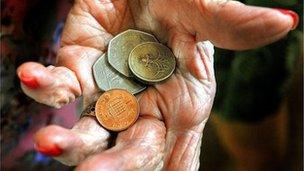What the cap on care costs doesn't do
- Published
- comments

Ministers want to cap the costs of social care, but there are some caveats
Ministers are hailing their changes to social care as the solution to the long-standing problem of how to care for the elderly.
The introduction of a £75,000 cap - if introduced - will arguably be the first time the system has been overhauled since it was created along with the NHS after the Second World War.
Understandably, the plans have been widely welcomed with campaigners willing to give the government credit for doing this at a time when the financial situation makes it harder to do than it has been for a long-time.
But despite the breakthrough it is not quite the panacea it may seem on first glance.
Many people will still not get any help from the state
The government is effectively saying it wants to see a partnership between the state and individual.
It is promising to pick up the really high costs, while leaving the individual to cover the cost of the average care package.
But less than a fifth of people face costs in excess of £75,000, meaning the majority of people will still have to pay all of their bill.
About a quarter of people do not develop any care needs - or very little, while for another quarter the costs of care are below £20,000.
However, for a third of people the bill is between £20,000 and £75,000 - they will not get any help unless they fall below the means-testing threshold as the least well-off do not have to pay the full costs of care.
But of course many will say that is better than the current situation where people can face unlimited costs - and the hope is that the insurance industry will develop products that will cover the costs people face.
You won't be able to shop around for the best services
The cap only includes services that are available at the normal council cost.
If you want to move into a luxury care home or pay to get the best help you will have to cover that extra cost yourself.
Any spending above what the local council would have paid for would not count towards the cap, leaving the individual to top up their package.
It means relying on the current quality of services available if you want to stay within that £75,000 sum.
Unfortunately the system, according to the Local Government Association, is drastically under-funded, which is hampering the ability to meet the needs of the elderly.
The government spends less than £10bn a year on social care for the elderly - a tenth of what is spent on the NHS and a quarter of the defence budget.
The criteria for being entitled to social care help will be extremely high
Just because you develop a care need, it does not mean you will fall within the system.
Only those with needs classed as severe or substantial will be entitled to help - that basically means you need round-the-clock help.
Any spending before you reach that level of need will not count towards the £75,000 cap.
It will mean many will still have to struggle to get by on their own until their situation worsens.
That is no different to how it is now, although a decade ago many councils were able to offer help to those with low or moderate needs.
The social care system, in a nutshell, will only be there for the most frail.
Care homes will still be expensive places
A cap of £75,000 is a substantial sum of money, but on top of that people face paying so-called accommodation costs.
This is to cover the cost of things such as food, bills and renting the room.
Of course, these are the kind of costs elderly people face if they are in their own home - and that is one of the reasons why there is a state pension.
But with annual "accommodation" bills often hitting the £10,000 mark, a care home place will be a more expensive arrangement than the status quo for most.